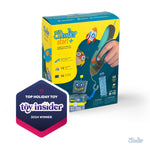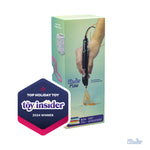Doodle-the-Dots (Even and Odd numbers)
Students will work in pairs to practice identifying and counting even and odd numbers (up to 20) in a connect-the-dots activity. Students will connect a string of even or odd numbers in order to draw a picture, and then they will bring the picture to life with the 3Doodler!
*This lesson may be used to practice even or odd numbers, depending on the worksheet used.

KnowledgeStudents havehad practice drawing straight lines, outlines and fill with the 3Doodler.
had practice identifying and counting even and odd numbers up to 20.
had practice writing even and odd numbers up to 20.
had experience with connect-the-dots.
had practice drawing straight lines, outlines and fill with the 3Doodler.
had practice identifying and counting even and odd numbers up to 20.
had practice writing even and odd numbers up to 20.
had experience with connect-the-dots.
ObjectivesStudents willrecognize odd numbers up to 20.
connect odd numbers with a pencil.
doodle to connect odd numbers with a 3Doodler.
fill and embellish their doodle-the-dots with a 3Dooder.
recognize odd numbers up to 20.
connect odd numbers with a pencil.
doodle to connect odd numbers with a 3Doodler.
fill and embellish their doodle-the-dots with a 3Dooder.
MaterialsStudents will need3Doodler (1 per pair)
Pencil (1 per pair)
3Doodler (1 per pair)
Pencil (1 per pair)
Lesson PlanInstructions
Step 1Whole Group: Review even and odd numbers with students. Write them on the board and have students recite these numbers together. Erase and have students recite individually and together.
*Note to the students that even numbers are the same numbers we count by 2s.
Step 2Review how to complete a connect-the-dots activity. Project your tablet or computer screen on the board for students to view the Doodle-the-Dots Worksheets. Explain how the different worksheets work with even and odd numbers.
Step 3Model how to connect the dots with a pencil first and then with the 3Doodler.
Step 4Model how to fill and embellish with a 3Doodler after the dots have been doodled. Note that it is easier to segment off large areas into smaller areas to fill with the 3Doodler.
Step 5Instruct students how to work on this activity with a partner. One student will be the Counter, counting the odd numbers. The other student will be the Connector, connecting the odd numbers with a pencil. Partners will take turns doodling, filling and embellishing their odd-numbers dinosaur or even-numbers cat together.
Step 6Circle to assist and assess.
Step 7Remind students to fill and embellish their dinosaur or cat after doodling the doodle-the-dots outline.
Whole Group: Review even and odd numbers with students. Write them on the board and have students recite these numbers together. Erase and have students recite individually and together.
*Note to the students that even numbers are the same numbers we count by 2s.
Review how to complete a connect-the-dots activity. Project your tablet or computer screen on the board for students to view the Doodle-the-Dots Worksheets. Explain how the different worksheets work with even and odd numbers.
Model how to connect the dots with a pencil first and then with the 3Doodler.
Model how to fill and embellish with a 3Doodler after the dots have been doodled. Note that it is easier to segment off large areas into smaller areas to fill with the 3Doodler.
Instruct students how to work on this activity with a partner. One student will be the Counter, counting the odd numbers. The other student will be the Connector, connecting the odd numbers with a pencil. Partners will take turns doodling, filling and embellishing their odd-numbers dinosaur or even-numbers cat together.
Circle to assist and assess.
Remind students to fill and embellish their dinosaur or cat after doodling the doodle-the-dots outline.
Wrap Up
Assessment
Possible Extensions
Resources
Vocabulary
counting numbers - Any number you can use for counting things: 1, 2, 3, 4, 5, ... (and so on).
creativity - the quality of having or showing an ability to make new things or think of new ideas.
draw - to produce a likeness or representation of by making lines on a surface.
even numbers - Any integer (never a fraction) that can be divided exactly by 2. The last digit will always be 0, 2, 4, 6 or 8.
math - the science of numbers and their operations, interrelations, combinations, generalizations, and abstractions and of space configurations and their structure, measurement, transformations, and generalizations.
odd numbers - Any integer (not a fraction) that cannot be divided exactly by 2. The last digit must be 1, 3, 5, 7 or 9.
skip counting - counting forwards or backwards by a number other than 1.
Educational Standards
Determine whether a group of objects (up to 20) has an odd or even number of members, e.g., by pairing objects or counting them by 2s; write an equation to express an even number as a sum of two equal addends.
Students will count and connect a group of dots by even or odd numbers up to 20.
Decompose (break down) a larger problem into smaller sub-problems with teacher guidance or independently.
Students will break down the process of recognizing, identifying and counting even and odd numbers by connecting, doodling and embellishing an outline of odd or even numbers.
Use technology to seek feedback that informs and improves their practice and to demonstrate their learning in a variety of ways.
Students will use the 3Doodler to connect even or odd numbers on an outline composed of even or odd numbers.
Create original works or responsibly repurpose or remix digital resources into new creations.
Students will use a 3Doodler to doodle together an outline of even or odd numbers and then creatively fill and embellish it.
Use collaborative technologies to work with others, including peers, experts or community members, to examine issues and problems from multiple viewpoints.
Students will seek feedback from peers throughout all stages of the doodle-the-dots activity, as well as the doodling portion.





